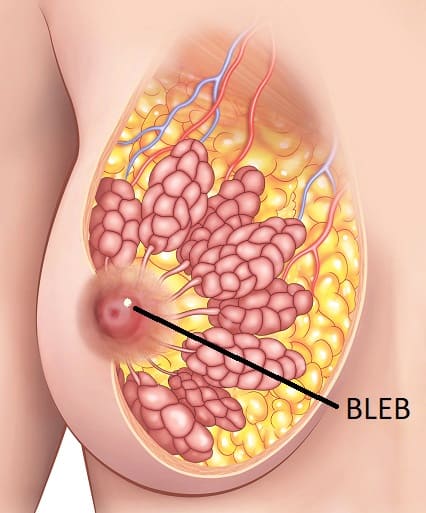
A bleb is a white (or clear, or yellow) spot or a blister on the surface of a nipple pore. There are 2 main reasons they can occur:
Blebs can cause a lot of pain but there are some treatments available so keep reading…
It is important for a bleb to be treated effectively, as they can prevent good drainage of the breast and result in blocked ducts or mastitis. Your baby is the best treatment for a bleb! They will do the best job of draining the breast and in lots of cases, the suction they create while breastfeeding will pop the blister spontaneously.
Sometimes, your breast may need a bit more help to get rid of the blister.

If that bleb is persistent, your doctor may prescribe a topical steroid cream to address the inflammation. The ABM guidelines advises topical moderate potency steroid cream such as 0.1% triamcinolone.
It’s a good idea to keep feeding or pumping after a blister has popped to make sure the breast is fully drained.
As we know these days, a blocked duct is actually caused by inflammation. That is the same for a bleb. So reducing inflammation may your best option to relieve the bleb. This may include:
When you have a bleb and blockage, you usually DON’T have a fever, or any other flu-like symptoms. The breast is not usually red, but it may be tender to touch and feel firm, possibly engorged. If the blockage doesn’t clear, this may lead to mastitis due to a build up of pressure in the breast tissue behind the blockage.
Even if your bleb clears, then you come down with mastitis soon after, the bleb is likely the cause.
We use low intensity therapeutic ultrasound to mobilise the milk sitting in that portion of the breast. We will also show you how to massage toward the nipple or to build pressure to assist with popping the bleb. Some focused massage right around the nipple and areola may help to break down scar tissue around recurrent bleb site. We also have plenty of relevant contacts to refer you to if you need some further assistance with breastfeeding challenges.
We’ve developed online video masterclasses to teach women like you HOW to massage their breast when they get an issue. These videos demonstrate what we teach women in clinic as well as the background anatomy of the breast so you understand your body better. Head over to our sister-company…
Fill in the contact form below and we will reply ASAP.
